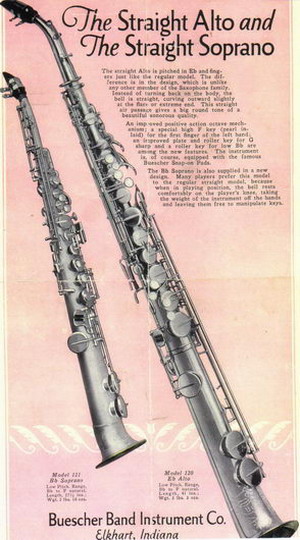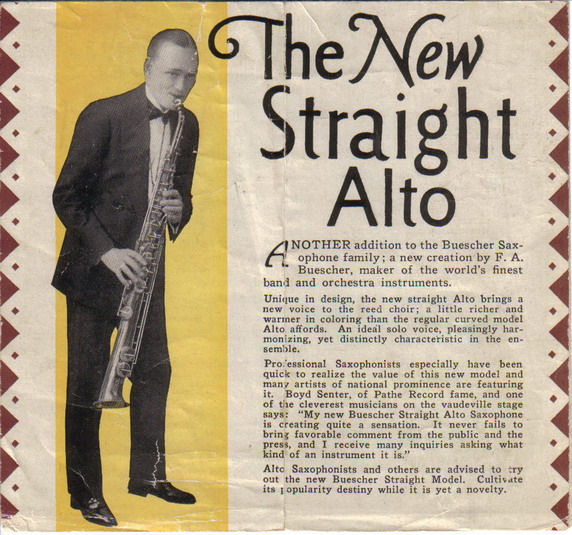Feature Page: Straight Altos and Tipped Sopranos

"THE STRAIGHT ALTO is pitched in Eb and fingers just like the regular model. The difference is in design, which is unlike any other member of the saxophone family. Instead of turning back on the body, the bell is straight, curving outward slightly the flare or extreme end. This straight air passage gives a big, round tone of a beautiful, sonorous quality.
An improved positive action octave mechanism; a special high F key (pearl inlaid) for the first finger of the left hand [which isn't shown in the advertisement]; an improved plate and roller key for G sharp, and a roller key for low Bb are among the new features. The instrument is, of course, equipped with the famous Buescher Snap-on Pads.
The Bb SOPRANO is also supplied in a new design. Many players prefer this model to the regular straight model, because when in playing position, the bell rests comfortably on player's knee, taking the weight of the instrument off the hands and leaving them free to manipulate the keys.
Bb Soprano Catalogue No. 121
Low Pitch Range Bb to F Natural. Length 27 1/2 inches.
Weight 2lbs, 10 oz.
Straight Eb Alto No. 120
Low Pitch Range Bb to F Natural. Length 41 inches.
Weight 5lbs, 3 oz."
| Model 121 | Model 120 | |
| Finish A | $85 | $90 |
| Finish E | $110 | $125 |
| Finish G | $130 | $160 |
| Finish J | $160 | $195 |
| Finish L | $275 | $350 |
Commentary: Things You Didn't Know

The exceptionally nice thing about these horns is, even though they were "novelty" instruments created to revive lagging sax sales, they are said (by most) to be exceptionally good instruments.
Possibly the number one least known fact about these horns is that there was a Tipped Bell C Soprano (see below pictures). These are exceptionally rare, probably because Buescher didn't make too many of them and because the C instrument craze was seriously waning by the time these beautiful instruments came into being.
The second least known fact is that there were two varieties of these horns: those with a one-piece body & bell and those with a two-piece. I can't tell when this split occurred -- I don't have that many pictures.
Is there a difference in quality between the one-piece and two-piece? In my opinion, from a design standpoint, the one-piece would be better: there is one less joint to leak from. In practice, however, a two-piece is probably easier to repair. I doubt that the bore is different, in either case.
The final least-known fact comes from SAXTEK: there were straight alto models that only extended to low B. These horns were probably made for no more than a year, or possibly as just protoypes.1
For information on the straight BARITONE, check out the page HERE.